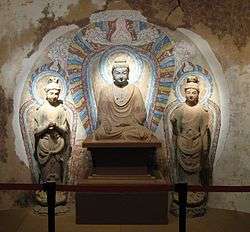Tiantishan Caves
The Tiantishan Caves (Chinese: 天梯山石窟; pinyin: Tiāntīshān shíkū) are a series of rock cut Buddhist cave temples in the Liangzhou District of Wuwei, Gansu, northwest China. Excavated from the eastern cliffs of the Huangyang River (黃羊河) in the Qilian Mountains from the time of the Northern Liang, carving, decoration and subsequent modification of the caves continued through the Northern Wei and Tang to the Qing dynasty.[1] The complex is identified with the Liangzhou Caves opened during the time of Juqu Mengxun "one hundred li to the south of Liangzhou", as recorded in the Spring and Autumn Annals of the Sixteen Kingdoms and Fayuan Zhulin.[1][2] The name Tiantishan consists of three Chinese characters (天梯山) that literally translate as "Ladder to Heaven Mountain".[3]

Caves
The Tang monk Daoxuan in his Ji shenzhou sanbao gantong lu ascribes the opening of Tiantishan to the Xiongnu king of Northern Liang Juqu Mengxun's devotion to "meritorious deeds" alongside his desire to avoid the impermanence of the city by fashioning caves from the mountains.[4] Contrary to the account in the Wei Shu of monks and Buddhist teachers relocating to the east after the conquest of the Northern Liang by the Northern Wei and subsequent persecution, structural, iconographic, and stylistic analysis shows that activity at the site continued.[2][4] A total of nineteen caves in three tiers have been identified:[2]
| Cave | Construction | Modifications | Type |
|---|---|---|---|
| Cave 1 | Northern Liang | Northern Wei, Tang (beginning, early, mid, and late), Western Xia, Yuan, Ming, Qing | central pillar |
| Cave 2 | beginning of the Tang | early Tang, Western Xia, Ming | square |
| Cave 3 | beginning of the Tang | Western Xia, Ming | square |
| Cave 4 | Northern Liang | Northern Wei, Tang (early and mid), Western Xia, Yuan, Ming, Qing | central pillar |
| Cave 5 | uncertain | uncertain | |
| Cave 6 | uncertain | Tang, Ming, Qing | square |
| Cave 7 | Northern Wei | Northern Zhou, Western Xia, Yuan, Ming | square |
| Cave 8 | Northern Wei | Northern Zhou, Sui, Tang (early and mid), Song, Ming | square |
| Cave 9 | Tang | Ming | square |
| Cave 10 | uncertain | uncertain | |
| Cave 11 | uncertain | uncertain | |
| Cave 12 | uncertain | uncertain | |
| Cave 13 | Tang | Western Xia, Yuan, Ming, Qing | |
| Cave 14 | Tang | Western Xia, Yuan, Ming | |
| Cave 15 | Northern Liang to Northern Wei | Western Xia, Yuan, Ming | |
| Cave 16 | Northern Wei | Western Xia, Yuan | |
| Cave 17 | Northern Liang to Northern Wei | Sui, Tang (mid), Western Xia, Yuan, Ming | |
| Cave 18 | Northern Liang | Northern Wei, Tang (late), Western Xia, Yuan, Ming, Qing | central pillar |
| Cave 19 | uncertain | uncertain | square |
Later history
Tiantishan disappeared from the historical record after the Tang dynasty.[2] While decoration and modification of the caves continued into the Qing dynasty, five suffered from collapse over the centuries, exacerbated by an earthquake in 1927.[2] Despite initial survey in the early 1950s demonstrating the importance of the site, in April 1959 the Gansu provincial government approved the construction of a reservoir that would flood two of the three tiers of caves when commissioned in May the following year.[2] In the interval, a research team from the Dunhuang Academy and Gansu Provincial Museum documented the site and excavated the collapsed caves, although all the written records and colour photographs and most of the black-and-white photographs have since been lost, along with most of the copies of the wall paintings.[2] Some 50 square metres (540 sq ft) of the paintings were detached, although the colours have since "faded after 40 years of natural weathering", and other than for the largest, most of the sculptures were taken down and removed to the Museum.[2] In 2001, in recognition of their significance as one of the earliest Buddhist grotto sites in the country, the Tiantishan Caves were designated a Major Historical and Cultural Site Protected at the National Level by SACH.[5]
See also
| Wikimedia Commons has media related to Tiantishan Caves. |
- Major National Historical and Cultural Sites (Gansu)
- Principles for the Conservation of Heritage Sites in China
- Detachment of wall paintings
- Mogao Caves
References
- Zhou Guoxin; Zhang Jianquan; Cheng Huaiwan (1997). "Pigment Analysis of Polychrome Statuary and Wall Paintings of the Tiantishan Grottoes". In Agnew, Neville (ed.). Conservation of Ancient Sites on the Silk Road: Proceedings of an International Conference on the Conservation of Grotto Sites (PDF). Getty Conservation Institute. pp. 362 ff. ISBN 978-0892364169.
- Zhang Xuerong; He Jingzhen; Wu Yiru (2000). 武威天梯山石窟 [The Grottoes in the Tianti Mountain, Wuwei]. Cultural Relics Publishing House. pp. 8, 292–5. ISBN 7501012202.
- "Tiantishan Grottoes (Wuwei)". China Daily. 2 November 2013. Retrieved 7 April 2017.
- John Lagerwey; Pengzhi Lü, eds. (2010). Early Chinese Religion: The Period of Division (220–589 AD). BRILL. pp. 584 ff. ISBN 978-9004175853.
- 全国重点文物保护单位 [Major National Historical and Cultural Sites] (in Chinese). State Administration of Cultural Heritage. Retrieved 7 April 2017.
External links
- (in Chinese) Tiantishan Caves (Dunhuang Academy)
- (in Chinese) Photos of the detachment of the paintings